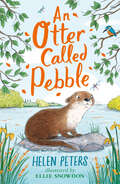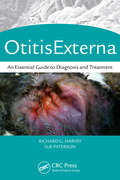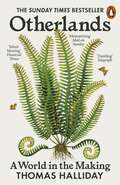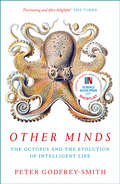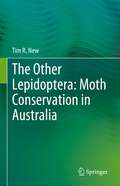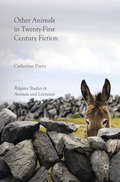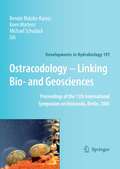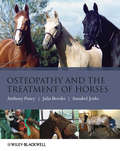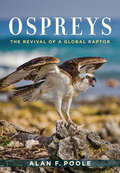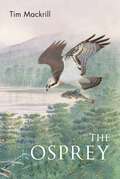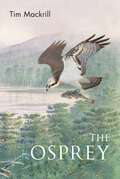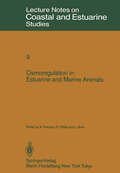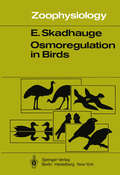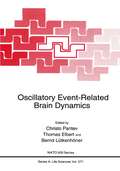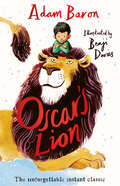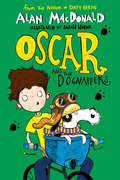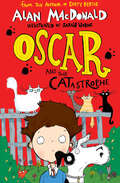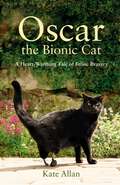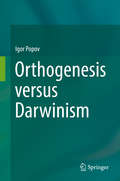- Table View
- List View
An Otter Called Pebble (The Jasmine Green Series #7)
by Helen PetersThe seventh in a fantastic series of animal stories for younger readers by Waterstones Children's Book Prize-shortlisted author Helen Peters, with beautiful black-and-white illustrations by Ellie Snowdon. Jasmine and Tom are amazed to spot a baby otter alone on the riverbank. When the little cub is swept downstream, they risk everything to rescue her. But where is her family? Can Jasmine and Tom find Pebble's home before it's too late? Brilliant storytelling that will make you laugh and cry, this is Dick King-Smith for a new generation. Look out for Jasmine's other adventures! A Piglet Called Truffle A Duckling Called Button A Sheepdog Called Sky A Kitten Called Holly A Lamb Called Lucky A Goat Called Willow
Otitis Externa: An Essential Guide to Diagnosis and Treatment
by Richard G. Harvey BVSc DVD Dip ECVD FSB Sue PatersonThe investigation and management of ear disease occupies a significant portion of a veterinary clinician's time. Otitis externa, in particular, is likely to be seen by a busy small animal clinician at least once a day. Otitis Externa: An Essential Guide to Diagnosis and Treatment provides a comprehensive source of information on the relevant struct
Otherlands: A World in the Making
by Thomas Halliday'The best book on the history of life on Earth I have ever read' Tom Holland'Epically cinematic... A book of almost unimaginable riches' Sunday TimesThis is the past as we've never seen it before. Otherlands is an epic, exhilarating journey into deep time, showing us the Earth as it used to exist, and the worlds that were here before ours. Travelling back in time to the dawn of complex life, and across all seven continents, award-winning young palaeobiologist Thomas Halliday gives us a mesmerizing up close encounter with eras that are normally unimaginably distant. Halliday immerses us in a series of ancient landscapes, from the mammoth steppe in Ice Age Alaska to the lush rainforests of Eocene Antarctica, with its colonies of giant penguins, to Ediacaran Australia, where the moon is far brighter than ours today. We visit the birthplace of humanity; we hear the crashing of the highest waterfall the Earth has ever known; and we watch as life emerges again after the asteroid hits, and the age of the mammal dawns. These lost worlds seem fantastical and yet every description - whether the colour of a beetle's shell, the rhythm of pterosaurs in flight or the lingering smell of sulphur in the air - is grounded in the fossil record. Otherlands is a staggering imaginative feat: an emotional narrative that underscores the tenacity of life - yet also the fragility of seemingly permanent ecosystems, including our own. To read it is to see the last 500 million years not as an endless expanse of unfathomable time, but as a series of worlds, simultaneously fabulous and familiar.
Other Minds: The Octopus And The Evolution Of Intelligent Life
by Peter Godfrey-SmithBBC R4 Book of the Week ‘Brilliant’ Guardian ‘Fascinating and often delightful’ The Times What if intelligent life on Earth evolved not once, but twice? The octopus is the closest we will come to meeting an intelligent alien. What can we learn from the encounter?
The Other Lepidoptera: Moth Conservation in Australia
by Tim R. NewConservation interest in moths, by far the predominant components of Lepidoptera, lags far behind that for butterflies, for which conservation practice provides many well-established lessons for extension to their near relatives. The needs of moths are at least as great, but their greater richness and variety, and far poorer documentation of diversity and biology over much of the world contribute to this lack of attention. Australia’s rich moth fauna, largely endemic and of global interest, illustrates many of the problems of developing wider interest and support for moth conservation. Numerous species (perhaps half the total fauna) are undescribed, and many are ecological specialists in restricted and vulnerable environments over small parts of the continent. Establishing their conservation status and needs whilst accepting that foundation knowledge is highly incomplete and much species-focused conservation is impracticable provides complex problems in setting priorities, based largely on wider diversity and effective advocacy. Most Australian vegetation systems, from grassland to forest and from sea-level to alpine zones, have been eroded in extent and quality since European settlement, resulting in massive habitat changes for native insects and to leave fragmented (and commonly degraded) remnants in which moths and others may persist. Recent surveys continue to increase recorded moth richness, reveal local faunal peculiarities, and indicate how assemblage changes may mirror wider environmental changes. This book is an overview of advances in documenting and interpreting moth diversity and ecology, to show how information from better-studied moth faunas can help in planning conservation of Australia’s moths through measures such as understanding the moths themselves by increased surveys and study, the factors influencing their diversity and wellbeing, and how such threats may be countered through increased coordinated conservation interest, commitment and management.
Other Animals in Twenty-First Century Fiction
by Catherine ParryThis book is about ordinary animals and how they are imagined in twenty-first century fiction. Examining contemporary animal representations and the fraught and potent distinctions humans fashion between themselves and all other animals, it asks how a range of novels make, re-make or un-make traditional conceptions of the creatures we love, admire, eat, vilify and abuse. Other Animals’ detailed readings of horses, an animalised human, a donkey, ants, chickens and chimpanzees develop new critical practices in Literary Animal Studies. They explore the connections between fictional animal representation, narrative form, ethics, and the lives and warm bodies of the real-world creatures that precede and exceed our imagination. Human-animal relationships are conditioned by our imaginative shapings of other animals, and by our sense of distinction from them, and Other Animals opens out how fictional animal forms and tropes respond to, participate in, or challenge the ways animals’ lives are lived out in consequence of human imaginings of them.
Other Animals in Twenty-First Century Fiction
by Catherine ParryThis book is about ordinary animals and how they are imagined in twenty-first century fiction. Examining contemporary animal representations and the fraught and potent distinctions humans fashion between themselves and all other animals, it asks how a range of novels make, re-make or un-make traditional conceptions of the creatures we love, admire, eat, vilify and abuse. Other Animals’ detailed readings of horses, an animalised human, a donkey, ants, chickens and chimpanzees develop new critical practices in Literary Animal Studies. They explore the connections between fictional animal representation, narrative form, ethics, and the lives and warm bodies of the real-world creatures that precede and exceed our imagination. Human-animal relationships are conditioned by our imaginative shapings of other animals, and by our sense of distinction from them, and Other Animals opens out how fictional animal forms and tropes respond to, participate in, or challenge the ways animals’ lives are lived out in consequence of human imaginings of them.
Ostrich (UEB Uncontracted)
This page shows an ostrich from the side with its small head in the top left of the page and tail at the centre right. There is a locator dot shown, which will be at the top left of the page when the image is the right way up.The ostrich is facing to the left so one eye can be found, and its beak is open. Directly down from its head, its long, slender, bare neck leads to its large, black feathered body.The ostrich, despite being flightless, has two large strong wings. One of these, with white feathers at the tip is shown in the centre of the image. To the right of its wing is its white floppy feathered tail. The ostrich stands on two very long, bare legs, with large toes and claws at the end.
Ostrich (UEB Contracted)
This page shows an ostrich from the side with its small head in the top left of the page and tail at the centre right. There is a locator dot shown, which will be at the top left of the page when the image is the right way up.The ostrich is facing to the left so one eye can be found, and its beak is open. Directly down from its head, its long, slender, bare neck leads to its large, black feathered body.The ostrich, despite being flightless, has two large strong wings. One of these, with white feathers at the tip is shown in the centre of the image. To the right of its wing is its white floppy feathered tail. The ostrich stands on two very long, bare legs, with large toes and claws at the end.
Ostrich (Large Print)
This page shows an ostrich from the side with its small head in the top left of the page and tail at the centre right. There is a locator dot shown, which will be at the top left of the page when the image is the right way up.The ostrich is facing to the left so one eye can be found, and its beak is open. Directly down from its head, its long, slender, bare neck leads to its large, black feathered body.The ostrich, despite being flightless, has two large strong wings. One of these, with white feathers at the tip is shown in the centre of the image. To the right of its wing is its white floppy feathered tail. The ostrich stands on two very long, bare legs, with large toes and claws at the end.
Ostracodology - Linking Bio- and Geosciences: Proceedings of the 15th International Symposium on Ostracoda, Berlin, 2005 (Developments in Hydrobiology #197)
by Renate Matzke-Karasz Koen Martens Michael SchudackThe great diversity of ostracod applications in biology and palaeontology is clearly illustrated by eighteen papers from the 15th International Symposium on Ostracoda. Collectively, the contributions provide a comprehensive update of ongoing research and the latest findings in ostracod sciences. You’ll learn how ostracods are used as model groups in a variety of research studies, ranging from evolutionary biology to climate change.
Osteopathy and the Treatment of Horses
by Anthony Pusey Julia Brooks Annabel JenksWritten by pioneering and internationally-renowned specialists in the field, this text provides clinically-orientated information on osteopathy as a treatment for horses. It explains the scientific rationale of how osteopathy works in animals, as well as providing a detailed working guide to the technical skills and procedures you need to know to perform safe and effective osteopathic procedures. Drawing on well established practices for humans this book provides details on the full variety of diagnostic and therapeutic osteopathic procedures that can be used on horses. Full of practical information, it demonstrates how professionals treating equine locomotor problems can adapt different procedures in different clinical settings. Over 350 colour images and detailed step-by-step instructions demonstrate the procedures and practice of osteopathy. Covers treatment both with and without sedation and general anaesthetic. This comprehensive text is written for students and practitioners of osteopathy with an interest in treating horses. It will also be useful to other allied therapists, and to veterinary practitioners who want to know more about the treatment of musculoskeletal problems.
Osteopathy and the Treatment of Horses
by Anthony Pusey Julia Brooks Annabel JenksWritten by pioneering and internationally-renowned specialists in the field, this text provides clinically-orientated information on osteopathy as a treatment for horses. It explains the scientific rationale of how osteopathy works in animals, as well as providing a detailed working guide to the technical skills and procedures you need to know to perform safe and effective osteopathic procedures. Drawing on well established practices for humans this book provides details on the full variety of diagnostic and therapeutic osteopathic procedures that can be used on horses. Full of practical information, it demonstrates how professionals treating equine locomotor problems can adapt different procedures in different clinical settings. Over 350 colour images and detailed step-by-step instructions demonstrate the procedures and practice of osteopathy. Covers treatment both with and without sedation and general anaesthetic. This comprehensive text is written for students and practitioners of osteopathy with an interest in treating horses. It will also be useful to other allied therapists, and to veterinary practitioners who want to know more about the treatment of musculoskeletal problems.
Ospreys: The Revival of a Global Raptor
by Alan F. PooleOspreys are one of the few bird species that are found throughout the world. From forests in Hokkaido to rivers in Oregon and islands off Australia, Ospreys steal the show as nature lovers easily watch them build their massive nests and tend to their young. The fact that the Osprey is one of the few large birds that can hover adds to its mystique, and to watch it plunge into the water, emerging with a fish clutched in its talons, is truly a sight one will remember. As widespread as Ospreys are, not long ago they were under threat of extinction. During the 1950s and '60s, scientists tied the decline of Osprey populations to the heavy use of DDT and other human pollutants. In the 1980s, Ospreys began a slow recovery due to the efforts of conservationists and through the resilience of the adaptable raptors themselves. Today they are again considered common in most parts of the world, although some populations remain threatened.In this gorgeously illustrated book, Alan F. Poole, one of America's premier Osprey experts, has written a lyrical expos;© of these majestic creatures, describing their daily habits and exploring their relationship with the environment. Ospreys celebrates the species' miraculous recovery from contaminants and hunters, chronicles their spectacular long-distance migrations, and unveils their vital role in bringing life to coastal habitats. Few other birds have such a hold on the human imagination. This book shows us why.
Ospreys: The Revival of a Global Raptor
by Alan F. PooleOspreys are one of the few bird species that are found throughout the world. From forests in Hokkaido to rivers in Oregon and islands off Australia, Ospreys steal the show as nature lovers easily watch them build their massive nests and tend to their young. The fact that the Osprey is one of the few large birds that can hover adds to its mystique, and to watch it plunge into the water, emerging with a fish clutched in its talons, is truly a sight one will remember. As widespread as Ospreys are, not long ago they were under threat of extinction. During the 1950s and '60s, scientists tied the decline of Osprey populations to the heavy use of DDT and other human pollutants. In the 1980s, Ospreys began a slow recovery due to the efforts of conservationists and through the resilience of the adaptable raptors themselves. Today they are again considered common in most parts of the world, although some populations remain threatened.In this gorgeously illustrated book, Alan F. Poole, one of America's premier Osprey experts, has written a lyrical expos;© of these majestic creatures, describing their daily habits and exploring their relationship with the environment. Ospreys celebrates the species' miraculous recovery from contaminants and hunters, chronicles their spectacular long-distance migrations, and unveils their vital role in bringing life to coastal habitats. Few other birds have such a hold on the human imagination. This book shows us why.
The Osprey (Poyser Monographs)
by Mr Tim MackrillA highly readable Poyser monograph on one of the most widespread raptors.The Osprey is a large, fish-eating bird of prey. Distinctively marked in deep brown and white, with a piercing yellow eye and powerful hooked bill, the Osprey snatches its prey in spectacular swoops above lakes and wetlands around the world – it is one of the most widespread of all birds. Persecuted mercilessly in Britain, it became extinct in the 1890s before returning to the famous Loch Garten in Scotland in the 1950s. The return of the bird has been slow, but reintroduction programmes elsewhere – notably at Rutland Water – have been successful, and this remarkable raptor is an increasingly common sight in our skies. This Poyser monograph is dedicated to this fine species and includes more than 150 colour photographs. The Osprey looks at the distribution, foraging ecology, migration, breeding behaviour and population dynamics of this spectacular bird, with emphasis placed on conservation efforts both in Britain and in the species' African haunts, which have been discovered only very recently thanks to advances in satellite tagging technology.
The Osprey (Poyser Monographs)
by Mr Tim MackrillA highly readable Poyser monograph on one of the most widespread raptors.The Osprey is a large, fish-eating bird of prey. Distinctively marked in deep brown and white, with a piercing yellow eye and powerful hooked bill, the Osprey snatches its prey in spectacular swoops above lakes and wetlands around the world – it is one of the most widespread of all birds. Persecuted mercilessly in Britain, it became extinct in the 1890s before returning to the famous Loch Garten in Scotland in the 1950s. The return of the bird has been slow, but reintroduction programmes elsewhere – notably at Rutland Water – have been successful, and this remarkable raptor is an increasingly common sight in our skies. This Poyser monograph is dedicated to this fine species and includes more than 150 colour photographs. The Osprey looks at the distribution, foraging ecology, migration, breeding behaviour and population dynamics of this spectacular bird, with emphasis placed on conservation efforts both in Britain and in the species' African haunts, which have been discovered only very recently thanks to advances in satellite tagging technology.
Osmoregulation in Estuarine and Marine Animals: Proceedings of the Invited Lectures to a Symposium Organized within the 5th Conference of the European Society for Comparative Physiology and Biochemistry - Taormina, Sicily, Italy, September 5–8, 1983 (Coastal and Estuarine Studies #9)
by A. Pequeux R. Gilles L. BolisOsmoregulation in Birds (Zoophysiology #12)
by E. SkadhaugeThe approach of this treatise is physiological throughout. In the eyes of the author it answers the rhetorical question raised by Maurice B. Visscher at the Physiology Congress in Washington D. C. in 1968: Does physiology exist? What he meant by this question was whether the fields of cellular physiology and physiology of the various organ systems had become so large that physiology as such had vanished. The firm answer is that physiology does indeed exist. Although it is important to study physiological problems at the subcellular level, it is importan- and equally difficult - to study organ regulation at the cellular level, organ interaction, and integration into the whole organism. An account of avian osmoregulation from an integrated point of view is attempted in this book. Since reading Homer W. Smith's From Fish to Philosopher and August Krogh's Osmoregulation in Aquatic Animals verte brate osmoregulation has been in the center of the author's interest. The focus was set on avian osmoregulation after personal contact with the School of Krogh when working in the laboratory of Bodil M. Schmidt-Nielsen. The fundamental concepts and isotope techniques introduced by Hans H. Ussing have been of constant inspiration. An excellent example for the study of osmoregulation at the cellular level was given by the late Jean Maetz. The writing of this book was suggested by Donald S. Farner who is thanked for thorough editorial assistance, and especially with help in the subtle semantic peculiarities of the English language.
Oscillatory Event-Related Brain Dynamics (Nato Science Series A: #271)
by Christo Pantev Thomas Elbert Bernd LütkenhönerHow does the brain code and process incoming information, how does it recog nize a certain object, how does a certain Gestalt come into our awareness? One of the key issues to conscious realization of an object, of a Gestalt is the attention de voted to the corresponding sensory input which evokes the neural pattern underly ing the Gestalt. This requires that the attention be devoted to one set of objects at a time. However, the attention may be switched quickly between different objects or ongoing input processes. It is to be expected that such mechanisms are reflected in the neural dynamics: Neurons or neuronal assemblies which pertain to one object may fire, possibly in rapid bursts at a time. Such firing bursts may enhance the synaptic strength in the corresponding cell assembly and thereby form the substrate of short-term memory. However, we may well become aware of two different objects at a time. How can we avoid that the firing patterns which may relate to say a certain type of move ment (columns in V5) or to a color (V 4) of one object do not become mixed with those of another object? Such a blend may only happen if the presentation times be come very short (below 20-30 ms). One possibility is that neurons pertaining to one cell assembly fire syn chronously. Then different cell assemblies firing at different rates may code different information.
Oscar’s Lion
by Adam BaronA magical coming-of-age story about a boy spending his first weekend without his parents . . . and the lion who comes to babysit him. Get ready to fall in love with this instant classic.
Oscar and the Dognappers (Ask Oscar Ser.)
by Alan MacDonaldThe second book in a brilliantly funny new series from bestselling Dirty Bertie author Alan MacDonald, about a boy and his incredible talking dog. Oscar's back … and he's got plenty to talk about! Sam had a very ordinary life, until Oscar the dog arrived on his doorstep. Because Oscar has a big secret – he can talk!
Oscar and the CATastrophe (Ask Oscar Ser. #3)
by Alan MacDonaldThe third book in a brilliantly funny new series for 6+ readers from bestselling Dirty Bertie author Alan MacDonald, about a boy and his incredible talking dog. Sam had a very ordinary life, until Oscar the dog arrived on his doorstep. Because Oscar has a big secret – he can talk!
Oscar: A Heart-Warming Tale of Feline Bravery
by Kate AllanWhen Kate’s beloved cat, Oscar, is found with both hind legs severed by a combine-harvester, Noel Fitzpatrick, star of Channel 4's The Supervet, agrees to try pioneering surgery to replace his legs with prosthetics. This is the amazing account of a feline destined to become the world’s first bionic cat.
Orthogenesis versus Darwinism
by Igor PopovThis book reviews the convoluted history of orthogenesis with an emphasis of non-English sources, untangles relationships between various concepts of directed evolution and argues whether orthogenesis has something to offer modern biology. Darwinism claims that evolution occurs by selection from an extensive random variability. An alternative viewpoint—that the material for variability is limited and organisms are predisposed to vary in certain directions—is the essence of evolutionary concepts that can be grouped together under the name of orthogenesis. Dating back to Lamarck, orthogenesis has existed in many guises. Branded as mystical and discarded as unscientific, it keeps re-emerging in evolutionary discussions.
